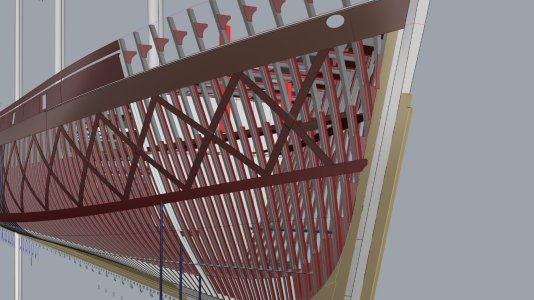Call for Contributors: Help Document the Structure of the Cutty Sark
For over two decades, I have been studying and documenting one of the most celebrated ships ever built — the Cutty Sark. What began as a personal technical investigation has evolved into a detailed visual and structural record, built on hundreds of hours of first-hand observation.Part of the reason I became involved in naval architecture professionally fifteen years ago was my fascination with this ship. Later, when I became a 3D artist for film and TV, I still found ships to be my niche. I am also an avid large-scale ship modeller, following in the footsteps of my father, who built builder’s models professionally for a shipping firm as well as private models in the 1950s and 60s.
This long-term study has now been picked up by a major publisher, who recognises the historical and technical importance of the work. The project is moving into its final stages of preparation, and I am seeking collaborators — people who know the ship or her contemporaries, and who may wish to contribute information, drawings, or imagery that could help make this the most complete study of her structure yet produced.
Why I Am Writing This Post
While I am necessarily limited in what I can reveal at this stage, I want to involve contributors early. Your points of view, observations, or clarifications could help shape an accurate and meaningful record of the ship, ensuring the final work is as thorough and precise as possible.Background
My interest in the Cutty Sark began over forty-five years ago and has grown into a sustained research project that has occupied much of my professional life. Over the years, I have had around 400 dedicated sessions aboard the ship, during which I have recorded and taken meticulous measurements of every accessible part of her structure. Thousands of photographs have been taken, and modern 3D scanning has also been used to capture precise data, providing further insight into the ship’s form and construction.The project was greatly aided during the 2007–2012 restoration, when I was in touch with the conservation team and able to document parts of the vessel rarely seen by the public.
Over that time, I have focused on building a comprehensive visual record of the ship’s internal and external structure — the frames, beams, and planking and plating that define her form; the iconic geometry of her hull; the proportions of her masts and spars; and the intricate web of rigging that gave her life.
The Aim of the Book
This book will focus on the ship herself: her fabric, form, and function. While a historical section will provide context, the emphasis will be on her structural history — how her physical form evolved, how she was modified through successive repairs and restorations, and what those changes reveal about 18th–19th century composite shipbuilding.Produced in the Style of the Anatomy of the Ship series, particularly the HMS Dreadnought or Agassiz, it will include over 280 highly detailed plans, covering hull frames, deck layouts, rigging diagrams, and structural sections — offering a visual and technical record unparalleled in scope.
As an overview of the Deckhouse section of the book, I will endeavour to lay out the scope of the detail. The chapter will not only show the layout of the exterior panels and it's iconic Gothic arches and roof but will go deeper and provide plans of how it is built. These plans could actually be used to build a new deckhouse.
We will first cover the framing structure of the house, from its dovetailed foundation beams to the mullions, transoms, and supporting beams, then its roof planking and innermost lining. We then move to the layers of wood panels that make up its outer panels, layer by layer, and lastly provide the internal General Arrangements of the interior. This approach also applies to the Saloon aft, though much of it is iron in its framing, whereas the deckhouses are entirely wood.
Further to this, things like the winches and pump have their own chapter, each with detailed drawings and part drawings.
An Invitation to Contribute
I am seeking contributions from:- Maritime historians and researchers with specialist knowledge of the Cutty Sark or other 18th-19th-century clippers.
- Restoration professionals and volunteers with documentation from past conservation work.
- Ship modellers and naval architects who have accurate plans or models.
- Photographers, archivists, and museum professionals with rare imagery.
- Sailmakers, riggers, or traditional shipwrights who can provide technical commentary.
- Photographs (structure, fittings, or interior spaces)
- Drawings, sketches, or plans from private archives
- Technical or historical notes from restoration work or research
- Written observations or commentary
Why It Matters
The Cutty Sark’s strength and elegance came from the ingenuity of her builders — the marriage of iron and wood, the way her frames curved to carry the planking and plating, and the balance of her spars. Much of this knowledge risks fading from view. Even though she has been restored, much of the structure is covered up by interactive displays and decorative elements like false tea chests, obscuring the details and views of her actual stucture.By gathering contributions now, we can preserve her structure — the essence of her design — for scholars, shipwrights, and enthusiasts worldwide.
Contact
Richard DunnNaval Architect, 3D Artist & Historian
richard71dunn@gmail.com
Last edited:




